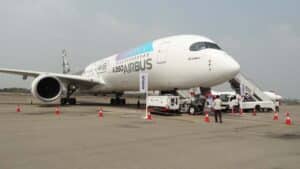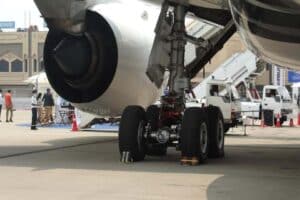Aerospace
What impact will the Airbus A350 have on Air India?
How Air India is raising its worldwide standards with the Airbus A350, the world’s most advanced and costliest commercial aeroplane.
As we all know, Air India is known for its heritage of Indian traditions. When JRD Tata initially established Air India, they intended to make it global famous, and they succeeded. From 1950 until 1990, Air India literally commanded the Indian and international sky, receiving numerous honours for their services. All credit goes to JRD Tata and his vision of personalizing services to customer needs and giving facilities and brand identification..
Following India’s privatization programme, many airlines began to compete with Air India, however after a few years, the firm’s earnings and debts began to rise. The majority of the actions made by previous management caused the aircraft to operate like a bull cart, which means entirely jammed. Due to changing aviation circumstances, fierce competition, and inadequate service from Air India.
Tata is now the new owner of Air India. The group is already involved in the aviation industry, with Airasia and Vistara affiliated with Singapore Airlines. Tata is a well-known group for providing high-quality services. Following the acquisition of debt-ridden Air India. The Group began the process of fleet rationalization. It recently decommissioned its Boeing 747 aircraft from the fleet, which is no longer operational due to the aircraft’s age.
Comparison of two legendary aircraft Boeing 777x vs Boeing 747 aircraft
Why could Air India not select Boeing aircraft?
When Air India considered reorganizing its fleet for international connections, it had the option of purchasing long-haul aircraft such as the Boeing 777, B787, or A350. Due to the halt of the Boeing 787, this aircraft may take a few more months to begin delivering. Another plane is the Boeing 777x, which is on the verge of being released into the market. Due to continued issues with production quality, Boeing has prioritised clearing certification of holding aircraft such as the B787 and B737 Max 10. As a result, the Boeing 777x has been delayed until 2025. Last but not least, the Airbus A350, which is famed for its innovative and cutting-edge technology, was given ample space to demonstrate its capabilities for Tata Air India.
Argentina seized a Boeing 747 in the midst of the confusion.
In March, it exhibited its aircraft at an Indian airfield and met with the Tata Group for future discussions. So, finally, Air India has decided to purchase the A350 aircraft. It has now been awarded the contract to supply advanced aircraft to India for the first time.
Boeing and Ethiopian Airlines Sign Memorandum of Understanding for New 777-8 Freighter
How the A350 heralds the arrival of new generations for Air India.
This aircraft was launched in 2015 with Qatar Airways as the launch client, and it has maintained high quality standards to this day, it is the best aircraft for the twenty-first century. However, Airbus has focused on the most advanced technology with this aircraft, which features new cabins and a long range.
The A350 is the first aircraft to arrive for Indian airlines. Previously, only the Boeing 787 was used by Air India, and Vistara was a new customer for that aircraft, but now Air India will fly the next generation aircraft, the Airbus A 350.
Certainly, this aircraft is incredibly smooth and up to date with the newest avionics and equipment. That allows the airline to improve the quality of its services to passengers while also attracting new passengers because its model is well known among passengers.
Because Air India operates long-haul flights with Boeing 777 to the United States and Europe, the A350 may be replaced with a few routes with higher demand. According to the source, the aircraft might enter the fleet by 2023.
When Air India was founded in early 1960, it was one of the few airlines that ordered Boeing 747 aircraft, which are fantastic aircraft airlines that carry the Indian kingdom historical theme concepts across livery and interior. The day has returned, and just like when choosing A350 aircraft, I’m wondering what kind of livery Air India intends to use with its newest and youngest aircraft fleet.
Let us know what you think about Air India’s decision to purchase A350 aircraft in the comments area.

Aerospace
Boeing Transfers Rocket Stage to NASA, Paving Way for Human Moon Mission

Boeing has achieved a significant milestone by providing NASA with the second core stage of the Space Launch System (SLS) rocket.
This crucial component, crafted at NASA’s Michoud Assembly Facility (MAF), is set to propel the Artemis II crew into lunar orbit, marking humanity’s return to deep space after a 50-year hiatus.
The monumental Boeing-built rocket stage, the largest element of the Artemis II mission, will embark on a journey aboard the Pegasus barge, traveling 900 miles to NASA’s Kennedy Space Center.
Comparison of two legendary aircraft B777x vs B747 aircraft:Click here
Upon arrival, it will be meticulously integrated with other essential Artemis II components, including the upper stage, solid rocket boosters, and NASA’s Orion spacecraft within the iconic Vehicle Assembly Building. This intricate integration process is a vital step toward the eagerly anticipated Artemis II launch, slated for 2025.
“Boeing-built products helped land humankind on the moon in 1969, and we’re proud to continue that legacy through the Artemis generation,” remarked Dave Dutcher, vice president and program manager for Boeing’s SLS program. “Together, with NASA and our industry partners and suppliers, we are building the world’s most capable rocket and paving the way to deep space through America’s rocket factory in New Orleans.”
NASA, Lockheed Martin Reveal X-59 Quiet Supersonic Aircraft:Click here
The delivery of Core Stage 2 marks a significant achievement in the evolution of the SLS rocket. Towering over 200 feet and powered by four RS-25 engines, this core stage, coupled with two solid-fueled booster rockets, will generate a staggering 8.8 million pounds of thrust. This immense power is crucial to launching Artemis II and future missions into the vast expanse of space.
The SLS rocket stands unparalleled in its capability to transport both crew and substantial cargo to the moon and beyond in a single launch. Its extraordinary capacity will facilitate the delivery of human-rated spacecraft, habitats, and scientific missions to destinations including the moon and Mars, ushering in a new era of space exploration.
-

 Travel1 week ago
Travel1 week agoAir India to Expand US Operations with Three New Routes After a Decade
-

 Travel2 weeks ago
Travel2 weeks agoWhy We Should Avoid These Stamps in a Passport
-

 Airlines1 month ago
Airlines1 month agoInvestigations Reveal Fake Chinese Titanium in Boeing and Airbus Jets
-

 Tech4 weeks ago
Tech4 weeks agoChina’s CATL Plans 1,800-Mile Electric Plane Launch by 2027
-

 Airport3 days ago
Airport3 days agoTop 10 Largest Airports in the World by Size
-

 Aerospace4 weeks ago
Aerospace4 weeks agoChina’s Fighter Jets Turn Wings into Autonomous Drones
-

 Airlines4 days ago
Airlines4 days agoAir India Rolls Out A350s for Delhi-New York JFK and Newark Routes
-

 Defence3 weeks ago
Defence3 weeks agoBoeing Enhances Chinook with New Engines and Block II Upgrades at $96 Million












